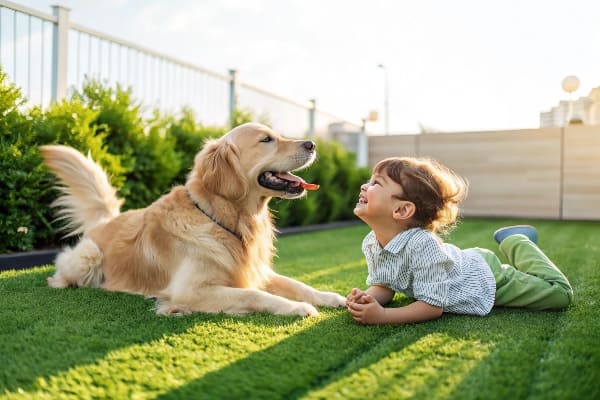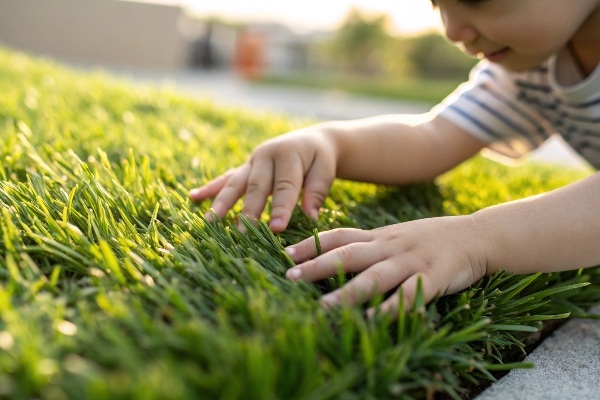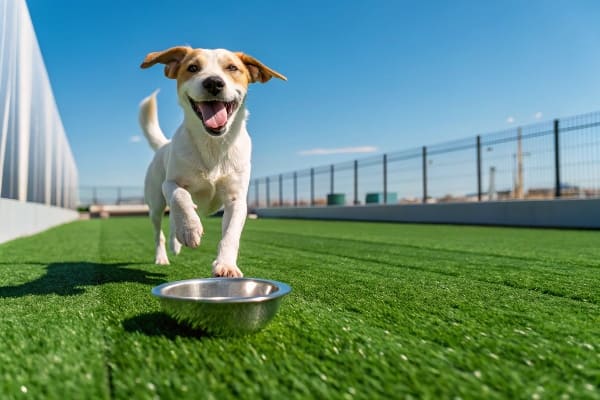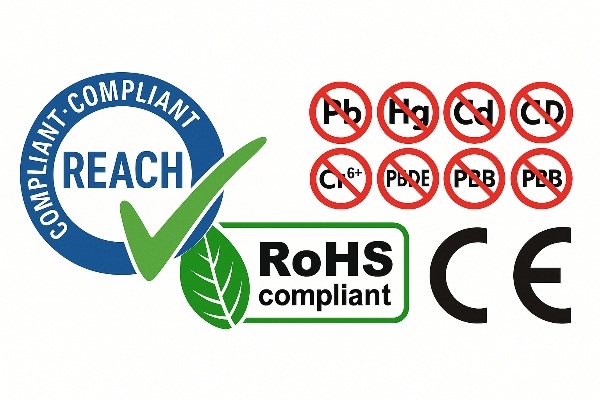Worried if artificial turf is a safe choice for your family? You want a perfect lawn, but the health of your kids and pets comes first. This fear can be paralyzing.
Yes, artificial grass is completely safe for kids and pets, provided it is sourced from a reputable manufacturer. High-quality turf is made from non-toxic materials and passes strict international safety standards like RoHS and REACH, ensuring it is free from harmful substances like lead and other heavy metals.

I understand this is one of the biggest questions people have. As an engineer and a parent, I would never recommend a product I didn’t trust completely. The safety of artificial grass isn’t just a simple yes or no; it depends on the quality of the raw materials and the integrity of the manufacturing process. Let’s break down the specifics for both kids and pets so you can feel confident in your decision. It all comes down to knowing what to look for.
Is artificial grass safe for kids?
You know kids. They run, they fall, and they put everything in their mouths. The thought of them playing on a surface with hidden chemicals is every parent’s biggest fear.
Yes, modern artificial grass is extremely safe for kids. Products that meet international standards are free of lead and other toxins. Moreover, its soft surface and the option to add a shock-absorbing underlayer can actually reduce injuries from falls, making it safer than hard, uneven ground.

When I was helping a local school choose turf for their new playground, the principal had the same concerns. He was worried about toxicity and scrapes. I walked him through the two main aspects of safety for children: the materials used and the physical properties of the surface itself. This gave him the confidence he needed.
Material Non-Toxicity
The materials are the most important factor. High-quality artificial grass fibers are made from polyethylene (PE) and the thatch layer from polypropylene (PP). These are the same types of stable, inert plastics used to make milk jugs, food containers, and children’s toys. They are chosen because they do not leach chemicals. The key is to verify this with certifications. A product that has passed RoHS and REACH testing has been checked for hundreds of harmful substances, so you know it’s clean.
Physical Safety
Beyond being non-toxic, the physical design of artificial turf makes it great for play areas. Unlike the old, scratchy turf from decades ago, today’s grass fibers are soft to the touch, reducing cuts and scrapes from falls. We can also install a foam shock pad underneath the turf, which provides extra cushioning. This is critical for playgrounds to meet fall-height safety requirements, making the surface much safer than dirt or concrete.
| Feature | Natural Grass | Certified Artificial Grass |
|---|---|---|
| Allergens | High risk from pollen and grass. | None. Hypoallergenic surface. |
| Chemicals | Often treated with pesticides and fertilizers. | None. No chemicals needed for maintenance. |
| Fall Surface | Uneven and hard ground. | Consistent, soft, and can add shock pads. |
| Hygiene | Harbors mud, bugs, and bacteria. | Easy to clean and drains quickly. |
Is artificial grass safe for pets?
You love your dog, but you don’t love the muddy paws, dug-up holes, and yellow patches on your lawn. You wonder if artificial grass is a solution or just another problem.
Absolutely. Artificial grass is a safe and practical solution for pet owners. It is made from non-toxic materials, so it is not harmful if licked or chewed. It is also highly durable to prevent digging and has excellent drainage for easy cleanup of pet waste.

One of my clients, Mohammed, runs a large contracting business in Saudi Arabia and often installs turf in residential communities. He told me that "pet-friendly" is one of the biggest requests he gets. His customers want to know two things: Is it safe for their animals, and can it handle the mess? The answer to both lies in the engineering of the product, specifically its material composition and its backing system.
Durability and Ingestion Safety
Pets, especially dogs, love to chew and dig. That’s why we focus so much on the tuft-lock strength of our turf. The fibers are locked so securely into the backing that even a persistent dog can’t pull them out. But even if a dog managed to chew off a blade, the polyethylene material is non-toxic and would simply pass through its digestive system. This is much safer than pets ingesting real grass that has been treated with pesticides or fertilizers.
Hygiene and Easy Maintenance
The design of pet-friendly turf is built around drainage. The backing is perforated with many drainage holes. When a pet urinates, the liquid flows straight through the turf and into the sub-base below, preventing puddles and odors. Cleaning is simple. You pick up solid waste just like you would on normal grass, then rinse the area with a hose. For any lingering smells, a simple spray with a pet-safe enzyme cleaner will neutralize it completely.
| Pet-Friendly Feature | Why It Matters |
|---|---|
| Non-Toxic Materials | Safe for pets to lick, chew, and play on. |
| Excellent Drainage | Urine passes through, preventing odors and bacteria. |
| Durable Tuft-Lock | Resists digging and pulling from claws and teeth. |
| No Mud or Pests | Keeps pets clean and reduces fleas and ticks. |
Is there artificial grass that is not toxic?
You’ve heard stories in the media about lead in older artificial turf fields. This makes you hesitate. How can you be 100% sure the product you are buying is completely safe?
Yes, all artificial grass from reputable manufacturers is non-toxic. The key to ensuring safety is to demand proof. Always ask your supplier for current, valid certificates for RoHS and REACH compliance. These independent lab tests are your guarantee that the product is free from harmful substances.

This is where I get serious with my customers, especially experienced buyers like Mohammed. Trust is important, but verification is everything. I tell them to never rely on a supplier’s word alone. The only way to be certain of a product’s safety is by reviewing the lab-tested documentation. A trustworthy supplier will be happy and ready to provide this. It’s a major red flag if they cannot or will not share their safety reports.
Understanding the Key Safety Certificates
You will hear two main certifications mentioned, and it’s good to know what they mean.
- RoHS (Restriction of Hazardous Substances): This standard tests for ten specific, highly toxic materials, including lead, mercury, and cadmium. It guarantees the product is free from the most well-known and dangerous heavy metals.
- REACH (Registration, Evaluation, Authorisation and Restriction of Chemicals): This is a much more comprehensive regulation from the European Union. It tests for hundreds of "Substances of Very High Concern" (SVHCs). If a product is REACH certified, it has passed one of the strictest safety standards in the world.
Your Checklist for Choosing a Safe Product
When you are buying artificial grass, a little due diligence goes a long way. Here is your simple checklist to ensure you get a non-toxic product:
- Ask for both RoHS and REACH certificates. Don’t accept one without the other.
- Check the date on the report. Make sure it is recent, as formulations can change.
- Verify the testing agency. Look for a name you recognize, like SGS or TUV.
- Confirm the result. The report should a have a clear "PASS" result listed.
Following these steps will give you total peace of mind.
Conclusion
So, quality artificial grass is a safe, durable, and clean solution for both kids and pets. To make the best choice, always verify the product with up-to-date safety certifications.
_画板-1.png)
_画板-1.png)